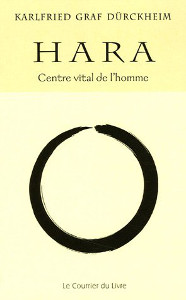
In Japanese, “hara” means simply the belly. A global concept of the posture is added behind this simple anatomic feature: The hara is the gravity center of the body situated precisely a few centimetres below the belly button. Moreover, an essential mental aspect is added to it: the physical and mental are so interdependent, that no one can control one aspect without controlling the other.
We are born with the hara. While we are babies, we seek our balance which comes naturally but which will be lost later if not practiced. The meaning of the exercise is to find (again) this balance whatever the situation: “every action which is repeated again and again conceals the possibility of inner perfection, making him who achieves it master of this action. In this sense “masterly” walking, running, speaking, writing and much else is possible […]” (p24). “Every art, every skill can become an opportunity to develop “on the Inner Way”, and so a saying of the Japanese becomes understandable; “Archery and dancing, flower-arranging and singing, tea-drinking and wrestling – it is all the same” (p25). Instrumental training is learning the balance of the body with the instrument.
Technique goes far beyond the basic aspect of physical balance. Learning a technique is nothing without the control of yourself “and if a man can do more than he is his skill often fails him in critical moments” […] “In this way the meaning of achieving outward and applied skill is transposed to the inner life. More important than outward success then is that personal quality which will, when developed produce not only the perfect external result, but which will have its real meaning and value within itself” (p24-25). “The self-practice in the service of an outward accomplishment serves, beyond it, the development of the inner man” (p28). Instrumental practice is therefore an experience of the self.
Hara as practice
The meaning of all exercises is to become transparent which is related to the right posture. Or, “right posture can be acquired only if one does three things: drop the shoulders, release the lower belly and put some degree of strength into it. For this it is sufficient to say “I am, I feel-myself down here, a little below the navel” (p121).
Feeling this strength, the shoulders, the neck, the arms and the hands become more relaxed. Rather than relaxing your shoulders, this is more about relaxing yourself with regards to your shoulders, as you come into your centre. Then, the top of the body feels lighter, freer, but at the same time, with a pleasant feeling of being heavier, wider, rooted in the trunk, strongly anchored in the whole pelvis.

In order to get a better understanding of the right posture, Dürckheim takes the example of horse riding: “Only with hara does that flexible and yet firm, relaxed posture which keeps the rider balanced, and which gives him that unforced control over his horse, release that “action in non-action” to which the horse willingly submits” (p125).
One can’t find this posture without working on breathing which is the prior condition to all exercises. “Right physical breathing comes from a movement of the diaphragm. If it is in order it is not the result of a doing, the breath comes and goes of itself” […] “The first thing that has to be learned is to let breathing happen. This is possible only to the extent that a person is able to cease directing the breath from his I” (p137-138).
A “simple” exercise is to observe the breath without interfering. Because it is only from the “depths” that the upward “right” tension could come, practicing the “right” breathing begins by a letting down in the body, meaning focusing on the expiration.
To carry out an action while using the hara reduces the effort since it is done organically and without the pressure of the I. The hara is also the preliminary condition to let the creative imagination free. Pictures appear spontaneously from the depths only if one can free oneself from the I, as it judges only by what it knows.
Hara provides answers far beyond questions of posture. With simple exercises, this book takes us to a full re-appropriation – physical and mental – of the body. Once started, it seems difficult to stop on the way. Every single activity of the day becomes practice. Including instrumental practice, the goal to achieve is the transparency of the gesture. If music is the sounding result of a gesture, its perfection can only be associated to the control of the hara.
Dürckheim (Karlfried Graf), Hara: The Vital Center Of Man, first edition 1962, translated from Hara ; die Erdmitte des Menschen by Sylvia-Monica von Kospoth, Vermont : Inner Traditions.